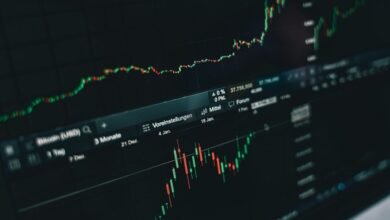2022554965 , 9094676085 , 3270686080 , 7704155728 , 6137450123 , 7816192296 , 2106425413 , 4164910665 , 8015845272 7209015768 Best Stocks to Buy in a Bear Market

During a bear market, investors seek stability amid declining equities. Strategic asset selection becomes crucial, emphasizing sectors that historically demonstrate resilience, such as consumer staples, healthcare, and utilities. These areas tend to provide downside protection and consistent income streams, yet identifying the most advantageous stocks requires careful analysis of fundamentals and market positioning. Examining how these defensive assets perform in downturns offers valuable insights for navigating uncertain conditions effectively.
Defensive Stocks: The Safe Havens During Market Downturns
During periods of market decline, investors often seek stability through defensive stocks, which typically belong to industries characterized by consistent demand regardless of economic cycles.
Market sentiment and investor behavior influence this shift, as strategic investors recognize these stocks’ resilience.
Such assets serve as a strategic hedge, providing stability and preserving capital amid fluctuating economic conditions.
Consumer Staples: Resilient Brands That Maintain Demand
Consumer staples companies often demonstrate stable sales amid economic downturns due to their essential product portfolios.
Their dominant market positions enable pricing power and consistent revenue streams despite market volatility.
This resilience underscores their strategic importance within diversified investment portfolios during bear markets.
Steady Sales During Downturns
In periods of economic downturn, companies within the consumer staples sector often demonstrate unwavering sales performance due to the essential nature of their products.
Strategic market timing and diversified stock holdings enhance resilience, allowing investors to maintain stable returns.
This sector’s consistent demand provides a foundation for portfolio stability, reinforcing the importance of stock diversification during volatile market conditions.
Dominant Market Positions
Major brands within the consumer staples sector often secure dominant market positions through extensive distribution networks, strong brand recognition, and consistent consumer loyalty.
This confers a significant market share and a durable competitive advantage, enabling resilient performance even in downturns. Such strategic positioning supports sustained demand, offering investors a stable foundation amidst economic volatility and preserving their pursuit of financial freedom.
Essential Product Offerings
Brands with established market dominance often rely on a portfolio of core products that consistently meet consumer needs regardless of economic conditions. In emerging markets, such essential offerings sustain demand, offering stability amid volatility.
Investors seeking freedom should recognize these resilient brands as safeguards, complementing growth strategies like cryptocurrency investments, which diversify risk and capitalize on evolving global economic landscapes.
Healthcare Sector: Stability and Growth in Uncertain Times
The healthcare sector’s defensive characteristics stem from consistent demand driven by essential services and aging populations, providing stability amid market volatility.
Simultaneously, ongoing innovation in pharmaceuticals, medical devices, and digital health presents growth opportunities that can offset sector downturns.
Strategically, investors may consider healthcare stocks for their resilience and potential to capitalize on technological advancements during uncertain economic periods.
Defensive Industry Resilience
The healthcare sector consistently demonstrates resilience during bear markets due to its essential nature and steady demand regardless of economic fluctuations.
Market sentiment remains relatively stable, supported by positive economic indicators such as consistent healthcare spending.
This stability offers strategic opportunities for investors seeking protection amid uncertain times, reinforcing healthcare’s role as a defensive industry with reliable growth prospects.
Innovation and Growth Potential
Amidst the inherent stability of the healthcare sector during economic downturns, its capacity for innovation and growth remains a critical factor for strategic investors.
Emerging technologies and startup innovations drive this potential, offering pathways for disruptive breakthroughs and long-term value creation.
These advancements enable healthcare firms to adapt swiftly, ensuring resilience and maintaining competitive advantage amid market uncertainties.
Utility Stocks: Reliable Income in Volatile Markets
Utility stocks are often regarded as a defensive sector due to their consistent revenue streams and essential service nature, making them attractive during market downturns. They provide stability through investments in renewable energy and telecommunications infrastructure, offering reliable income streams.
This strategic positioning supports financial independence while navigating volatility, appealing to investors seeking resilient assets with growth potential.
Technology Giants: Innovators With Strong Balance Sheets
Technology giants have established themselves as leaders in innovation, maintaining robust financial positions that withstand market fluctuations.
Their strategic focus on Artificial Intelligence and Cloud Computing underscores resilience and growth potential.
These companies’ strong balance sheets enable continued investment and adaptation, providing investors with a foundation of stability and future-oriented innovation in an uncertain economic landscape.
Dividend Aristocrats: Consistent Payers for Steady Income
Dividend Aristocrats consist of a select group of companies within the S&P 500 that have demonstrated a consistent track record of increasing dividends for at least 25 consecutive years.
Their focus on dividend growth provides income stability during downturns, appealing to investors seeking reliable cash flow and strategic wealth preservation.
These stocks offer resilience through disciplined dividend policies and steady income streams.
Value Stocks: Undervalued Opportunities in a Downturn
Value stocks represent companies whose shares are trading below their intrinsic worth, often due to temporary mispricings or economic uncertainties.
During downturns, emerging markets may present undervalued opportunities, while strategic investors consider cryptocurrency investments as alternative assets.
Identifying these undervalued opportunities requires disciplined analysis, offering the potential for significant gains once market conditions stabilize and confidence returns.
Gold and Precious Metals: Hedging Against Market Risks
Gold and other precious metals serve as strategic hedges during periods of heightened market volatility and economic uncertainty. They offer a tangible store of value independent of traditional financial assets.
A well-executed gold investment in precious metals provides diversification, preserves wealth, and enhances portfolio resilience. This approach appeals to investors seeking financial freedom and risk mitigation amid turbulent markets.
Conclusion
Historically, defensive stocks and precious metals have demonstrated resilience, with consumer staples and gold outperforming broader markets by over 20% during downturns. Such assets offer strategic downside protection and income stability in bear markets. Incorporating a diversified mix of defensive sectors, value opportunities, and hedging instruments can optimize risk-adjusted returns. Investors attuned to these data-driven insights enhance their capacity to preserve capital and position portfolios for a robust recovery when market conditions improve.




